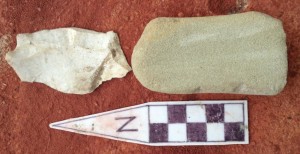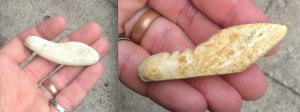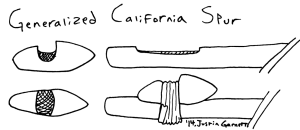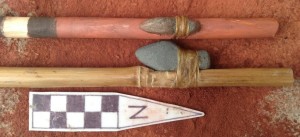-Justin Garnett, 2/25/2014
California stone atlatl spurs are fast and fun to make, and make good “entry level” projects into the the world of “Aboriginal” stone work (“Aboriginal” crafts can be thought of as those projects which incorporate no modern tools in their production). There are several different types of California stone spur, each with their own design specifics, but this is beyond the scope of this small article, and therefore in this article I will be using generalities.

Fig 2: Tools needed to make a California spur. Sandstone block, and flake (for roughing up hafting grooves).
Simple stone spurs are very quick and easy to make from small pebbles. The method I use is strict grinding, with no pecking. Such a small piece would be risky (To the fingers as well as the piece!) to peck. My method is to follow the advice that it’s a good idea to start with a blank that already approximates the shape of the intended object, in order to minimize manufacture time and effort.
The only tools required to make this type of spur are sandstones (or other hard stones, concrete blocks, or even sandpaper), time, and patience. Simply start with a rounded pebble, and alternately grind the sides until the desired shape is formed. When the overall shape is done, I like to grind the notches by rubbing against a right angle on a rock or piece of concrete. This will wear a nice, neat groove for hafting. Occasionally, I score the inside of this groove to allow the sinew binding to take better hold. These score marks can be made with stone flakes quite easily. Care must be taken not to press too hard, but a steady sawing/rasping motion will produce good score marks in most softer stones rather quickly. After all other work is done, I flatten off the bottom side of the spur, to make a nice, even, level surface to make good contact with the shaft of the atlatl.
Spurs have been found which were made of stone as soft as serpentine and steatite (Riddell and McGeein, 1969) and I have made and used spurs of shales, mudstones, limestones, igneous rocks, and even harder steatites. None of these spurs have really been a great hardship to make. From a suitable blank, a good spur can be had in a few minutes to half an hour of grinding-in many cases you’ll spend less time grinding out your spur than waiting for the sinew you’re binding it to the atlatl with to dry.
I like to attach these spurs to simple rod-bodied atlatls, similar to those used by the Nazca, Moche, Inca, Las Palmas, and occupants of Nicolarson Cave. This type of “simple” atlatl has a great time depth, and is likely the basic type to which many California type stone spurs were originally attached. I find carving a little “shelf” or flat spot on the atlatl provides a good seat for the spur, and tight binding of gut or sinew around the groove will hold it in place wonderfully.

Fig 3: Illustrates “good” blank selection. Stone’s natural form (left) is close to intended shape of finished spur (right), minimizing labor and time of production.
McGeein and Riddell state that several of the type II spurs found in the Sacremento region appear to be too small to be useful atlatl spurs, and ascribe to the the possible function of “gaming pieces”. These “small” spurs appear to be (to use the smallest shown in McGeein and Riddell, 1969, fig 1m, as as example) nearly 2cm in length, .5cm in height, and 2.5mm in functional height (to the center of the spur). They are small, but not so small that they couldn’t be useful for throwing lighter darts, particularly if the spur were slightly angled with respect to the long axis of the atlatl to which it was tied, the atlatl to which it was attached was grooved for loading, or if the darts thrown with it were hollow-butted and thin walled, such as darts with mainshafts of river cane or phragmites. In such a dart, all that is needed is contact with the lower rim of the dart nock. Of course, it is also reasonable to assume that these objects may have had an entirely different function altogether.
In summary, these spurs are simple, quick to make, functional, and a good “Beginner” level “aboriginal” craft. Hafting can be kind of tricky at first, but with a little practice you’ll be able to mount these securely. The amount of time taken to finish these spurs is directly related to the similarity of the intended spur shape to the natural shape of the stone selected. They may even take no time at all to make, if a stone happens to already have a suitable shape!

Fig 1: a drawing of a generalized California stone atlatl spur, and proposed method of hafting. Click to enlarge.
References:
Francis A. Riddell and Donald F. McGeein, “Atlatl Spurs from California”, American Antiquity, Vol. 34, No. 4 (Oct., 1969), pp. 474-478
Article Stable URL: http://www.jstor.org/stable/277746


